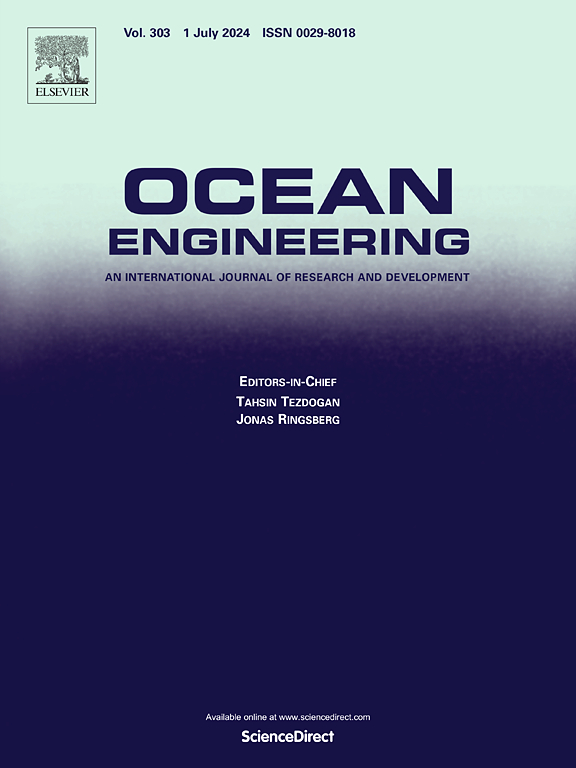Numerical study of Bragg resonance reflection for wave energy converter arrays in a two-dimensional viscous wave tank
IF 4.6
2区 工程技术
Q1 ENGINEERING, CIVIL
引用次数: 0
Abstract
Bragg resonance occurs when the spacing between periodic coastal structures is approximately half the incident wavelength, which significantly reduces the energy extraction efficiency of wave energy converter (WEC) arrays. This effect was studied by establishing a quasi-two-dimensional viscous numerical wave tank (NWT) using a computational fluid dynamics (CFD) approach to simulate nonlinear wave interactions with a linear array of three floating WECs. Following convergence analysis and model validation, the wave propagation, dynamic responses and energy capture characteristics of the array were evaluated under three conditions: fixed, freely heaving, and energy-extracting. Bragg resonance occurred at 2S/L = 1.2 in the fixed case and at 2S/L = 0.9 in the moving case, corresponding to phase-up and phase-down shifts, respectively. Under energy-extracting conditions, a substantial power reduction of up to 53.1 % was observed during resonance, with the first and third WECs oscillating in phase and the middle WEC in counter-phase. The adverse effect of Bragg resonance on power output became more pronounced with increasing power take-off (PTO) levels. These findings offer practical insights for the design of floating breakwaters and the optimization of WEC array configurations to improve energy performance.
二维粘性波槽中波能转换阵列Bragg共振反射的数值研究
当周期性海岸结构之间的间距约为入射波长的一半时,会发生布拉格共振,从而显著降低波能转换器阵列的能量提取效率。通过建立一个准二维粘性数值波槽(NWT),利用计算流体动力学(CFD)方法模拟了三个浮动WECs线性阵列与非线性波的相互作用,研究了这种效应。通过收敛性分析和模型验证,对固定、自由起伏和能量提取三种条件下阵列的波传播、动态响应和能量捕获特性进行了评估。固定情况下在2S/L = 1.2时发生布拉格共振,运动情况下在2S/L = 0.9时发生布拉格共振,分别对应于上相移和下相移。在能量提取条件下,谐振过程中观察到功率降低高达53.1%,第一和第三个WEC为同相振荡,中间WEC为反相振荡。随着功率输出(PTO)水平的增加,布拉格共振对功率输出的不利影响变得更加明显。这些发现为浮式防波堤的设计和优化WEC阵列配置以提高能源性能提供了实用的见解。
本文章由计算机程序翻译,如有差异,请以英文原文为准。
求助全文
约1分钟内获得全文
求助全文
来源期刊

Ocean Engineering
工程技术-工程:大洋
CiteScore
7.30
自引率
34.00%
发文量
2379
审稿时长
8.1 months
期刊介绍:
Ocean Engineering provides a medium for the publication of original research and development work in the field of ocean engineering. Ocean Engineering seeks papers in the following topics.
 求助内容:
求助内容: 应助结果提醒方式:
应助结果提醒方式:


